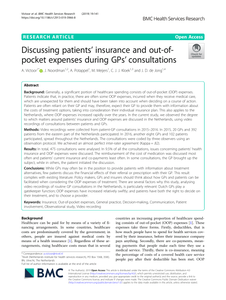Background: Generally, a significant portion of healthcare spending consists of out-of-pocket (OOP) expenses. Patients indicate that, in practice, there are often some OOP expenses, incurred when they receive medical care, which are unexpected for them and should have been taken into account when deciding on a course of action. Patients are often reliant on their GP and may, therefore, expect their GP to provide them with information about the costs of treatment options, taking into consideration their individual insurance plan. This also applies to the Netherlands, where OOP expenses increased rapidly over the years. In the current study, we observed the degree to which matters around patients' insurance and OOP expenses are discussed in the Netherlands, using video recordings of consultations between patients and GPs. Methods: Video recordings were collected from patient-GP consultations in 2015-2016. In 2015, 20 GPs and 392 patients from the eastern part of the Netherlands participated. In 2016, another eight GPs and 102 patients participated, spread throughout the Netherlands. The consultations were coded by three observers using an observation protocol. We achieved an almost perfect inter-rater agreement (Kappa = .82). Results: In total, 475 consultations were analysed. In 9.5% of all the consultations, issues concerning patients' health insurance and OOP expenses were discussed. The reimbursement of the cost of medication was discussed most often and patients' current insurance and co-payments least often. In some consultations, the GP brought up the subject, while in others, the patient initiated the discussion. Conclusions: While GPs may often be in the position to provide patients with information about treatment alternatives, few patients discuss the financial effects of their referral or prescription with their GP. This result complies with existing literature. Policy makers, GPs and insurers should think about how GPs and patients can be facilitated when considering the OOP expenses of treatment. There are several factors why this study, analysing video recordings of routine GP consultations in the Netherlands, is particularly relevant: Dutch GPs play a gatekeeper function; OOP expenses have increased relatively swiftly; and patients have both the right to decide on their treatment, and to choose a provider.
DOCUMENT

This experimental study with a pre-post and follow-up design evaluates the financial education program “SaveWise” for ninth grade students in the Netherlands (n = 713). SaveWise adopts a holistic approach, emphasizing action rather than mere cognition. Benefitting from explicit instruction embedded in real-life contexts, students in the program set a personal savings goal and are coached on how to achieve it. The short-term treatment results indicated that SaveWise expanded the students’ level of financial knowledge; encouraged their intentions to save more, spend less and earn an income; and broadly improved their financial and savings behavior. The program demonstrated that it could serve as an effective and low-cost method to enhance the financial literacy of pre-vocational students, a financially vulnerable group. Although long-term effects were expressed only through financial socialization, this study offers evidence linking curricula to increased knowledge and improved behavior for a specific sample of students.
MULTIFILE

In most countries, maternal and newborn care is fragmented and focused on identification and treatment of pathology that affects only the minority of women and babies. Recently, a framework for quality maternal and newborn care was developed, which encourages a system-level shift to provide skilled care for all.This care includes preventive and supportive care that works to strengthen women’s capabilities and focuses on promotion of normal reproductive processes while ensuring access to emergency treatment when needed. Midwifery care is pivotal in this framework, which contains several elements that resonate with the main dimensions of primary care. Primary health care is the first level of contact with the health system where most of the population’s curative and preventive health needs can be fulfilled as close as possible to where people live and work. In this paper, we argue that midwifery as described in the framework requires the application of a primary care philosophy for all childbearing women and infants. Evaluation of the implementation of the framework should therefore include tools to monitor the performance of primary midwifery care.
MULTIFILE
